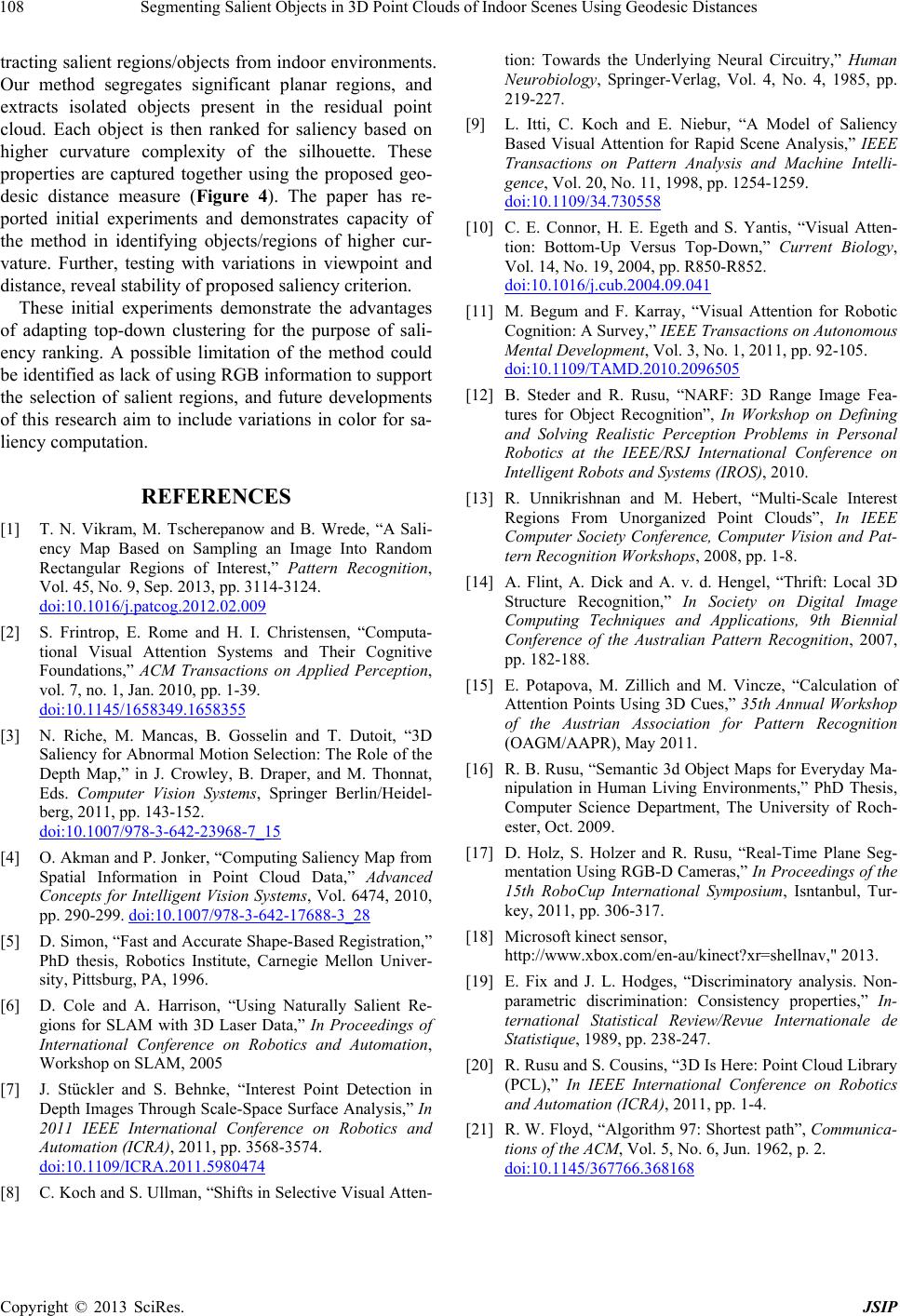
Segmenting Salient Objects in 3D Point Clouds of Indoor Scenes Using Geodesic Distances
Copyright © 2013 SciRes. JSIP
108
tracting salient regions/objects from indoor environments.
Our method segregates significant planar regions, and
extracts isolated objects present in the residual point
cloud. Each object is then ranked for saliency based on
higher curvature complexity of the silhouette. These
properties are captured together using the proposed geo-
desic distance measure (Figure 4). The paper has re-
ported initial experiments and demonstrates capacity of
the method in identifying objects/regions of higher cur-
vature. Further, testing with variations in viewpoint and
distance, reveal stability of propo sed saliency criterion.
These initial experiments demonstrate the advantages
of adapting top-down clustering for the purpose of sali-
ency ranking. A possible limitation of the method could
be identified as lack of using RGB informatio n to suppo rt
the selection of salient regions, and future developments
of this research aim to include variations in color for sa-
liency computation.
REFERENCES
[1] T. N. Vikram, M. Tscherepanow and B. Wrede, “A Sali-
ency Map Based on Sampling an Image Into Random
Rectangular Regions of Interest,” Pattern Recognition,
Vol. 45, No. 9, Sep. 2013, pp. 3114-3124.
doi:10.1016/j.patcog.2012.02.009
[2] S. Frintrop, E. Rome and H. I. Christensen, “Computa-
tional Visual Attention Systems and Their Cognitive
Foundations,” ACM Transactions on Applied Perception,
vol. 7, no. 1, Jan. 2010, pp. 1-39.
doi:10.1145/1658349.1658355
[3] N. Riche, M. Mancas, B. Gosselin and T. Dutoit, “3D
Saliency for Abnormal Motion Selection: The Role of the
Depth Map,” in J. Crowley, B. Draper, and M. Thonnat,
Eds. Computer Vision Systems, Springer Berlin/Heidel-
berg, 2011, pp. 143-152.
doi:10.1007/978-3-642-23968-7_15
[4] O. Akman and P. Jonker, “Computing Saliency Map from
Spatial Information in Point Cloud Data,” Advanced
Concepts for Intelligent Vision Systems, Vol. 6474, 2010,
pp. 290-299. doi:10.1007/978-3-642-17688-3_28
[5] D. Simon, “Fast and Accurate Shape-Based Registration,”
PhD thesis, Robotics Institute, Carnegie Mellon Univer-
sity, Pittsburg, PA, 1996.
[6] D. Cole and A. Harrison, “Using Naturally Salient Re-
gions for SLAM with 3D Laser Data,” In Proceedings of
International Conference on Robotics and Automation,
Workshop on SLAM, 2005
[7] J. Stückler and S. Behnke, “Interest Point Detection in
Depth Images Through Scale-Space Surface Analysis,” In
2011 IEEE International Conference on Robotics and
Automation (ICRA), 2011, pp. 3568-3574.
doi:10.1109/ICRA.2011.5980474
[8] C. Koch and S. Ullman, “Shifts in Selective Visual Atten-
tion: Towards the Underlying Neural Circuitry,” Human
Neurobiology, Springer-Verlag, Vol. 4, No. 4, 1985, pp.
219-227.
[9] L. Itti, C. Koch and E. Niebur, “A Model of Saliency
Based Visual Attention for Rapid Scene Analysis,” IEEE
Transactions on Pattern Analysis and Machine Intelli-
gence, Vol. 20, No. 11, 1998, pp. 1254-1259.
doi:10.1109/34.730558
[10] C. E. Connor, H. E. Egeth and S. Yantis, “Visual Atten-
tion: Bottom-Up Versus Top-Down,” Current Biology,
Vol. 14, No. 19, 2004, pp. R850-R852.
doi:10.1016/j.cub.2004.09.041
[11] M. Begum and F. Karray, “Visual Attention for Robotic
Cognition: A Survey,” IEEE Transactions on Autonomous
Mental Development, Vol. 3, No. 1, 2011, pp. 92-105.
doi:10.1109/TAMD.2010.2096505
[12] B. Steder and R. Rusu, “NARF: 3D Range Image Fea-
tures for Object Recognition”, In Workshop on Defining
and Solving Realistic Perception Problems in Personal
Robotics at the IEEE/RSJ International Conference on
Intelligent Robots and Systems (IROS), 2010.
[13] R. Unnikrishnan and M. Hebert, “Multi-Scale Interest
Regions From Unorganized Point Clouds”, In IEEE
Computer Society Conference, Computer Vision and Pat-
tern Recognition Workshops, 2008, pp. 1-8.
[14] A. Flint, A. Dick and A. v. d. Hengel, “Thrift: Local 3D
Structure Recognition,” In Society on Digital Image
Computing Techniques and Applications, 9th Biennial
Conference of the Australian Pattern Recognition, 2007,
pp. 182-188.
[15] E. Potapova, M. Zillich and M. Vincze, “Calculation of
Attention Points Using 3D Cues,” 35th Annual Workshop
of the Austrian Association for Pattern Recognition
(OAGM/AAPR), May 2011.
[16] R. B. Rusu, “Semantic 3d Object Maps for Everyday Ma-
nipulation in Human Living Environments,” PhD Thesis,
Computer Science Department, The University of Roch-
ester, Oct. 2009.
[17] D. Holz, S. Holzer and R. Rusu, “Real-Time Plane Seg-
mentation Using RGB-D Cameras,” In Proceedings of the
15th RoboCup International Symposium, Isntanbul, Tur-
key, 2011, pp. 306-317.
[18] Microsoft kinect sensor,
http://www.xbox.com/en-au/kinect?xr=shellnav," 2013.
[19] E. Fix and J. L. Hodges, “Discriminatory analysis. Non-
parametric discrimination: Consistency properties,” In-
ternational Statistical Review/Revue Internationale de
Statistique, 1989, pp. 238-247.
[20] R. Rusu and S. Cousins, “3D Is Here: Point Cloud Library
(PCL),” In IEEE International Conference on Robotics
and Automation (ICRA), 2011, pp. 1-4.
[21] R. W. Floyd, “Algorithm 97: Shortest path”, Communica-
tions of the ACM, Vol. 5, No. 6, Jun. 1962, p. 2.
doi:10.1145/367766.368168